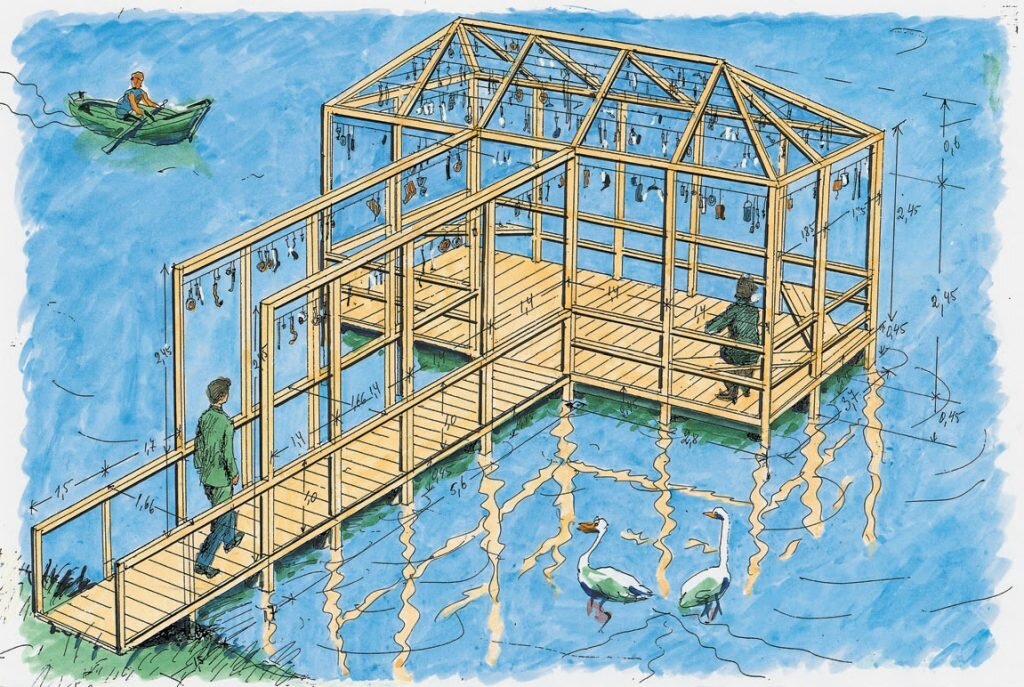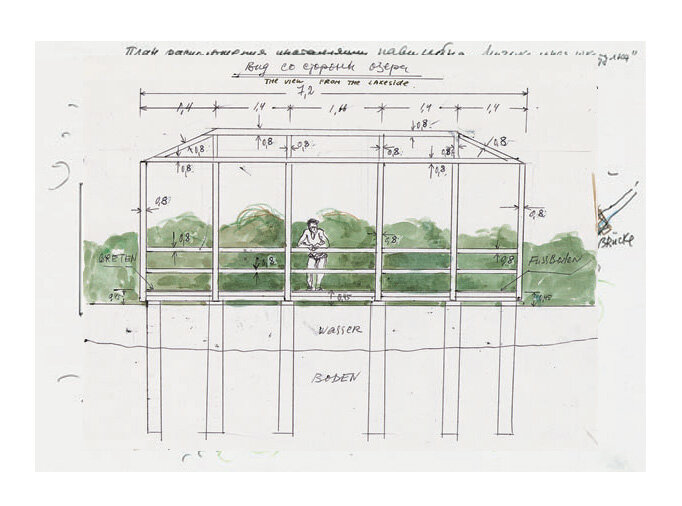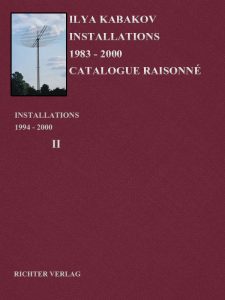Music on the Water
YEAR: 1996
CATALOG NUMBER: 97
PROVENANCE
The Artist
Collection Landeskulturzentrum Salzau, Salzau
EXHIBITIONS
Salzau, Landeskulturzentrum Salzau
Permanent installation, 9 Mar 1996
DESCRIPTION
A New Instrument
If the installation in its constructive, or more precisely, wooden part remained entirely unchanged, then its musical ‘metal’ part was entirely re-worked, composed anew. This concerns both the arrangement of the strings as well as the type and selection of the ‘instruments’ themselves. The original envisioned the strings with the instruments running along the entire perimeter of the ‘corridor’ and ‘gazebo’ under the upper beam and also arranged under the non-existent roof. Such a system, as soon as we attempted it, didn’t work at all in the visual sense. A new resolution was found in which the arrangement of the strings and the instruments forms a more compact block and arises not around but inside the gazebo, above the head of the visitor as an entirely autonomous musical instrument, unexpected in appearance.
Now what was achieved was an entirely different effect: the structure of the gazebo and the corridor did not serve as a place for hanging up the resounding objects, but rather an autonomous instrument is stretched inside the gazebo, and for which the gazebo itself serves as a sort of unique ‘sounding-board,’ similar to a guitar or another stringed instrument. Nothing hangs in the corridor – the corridor itself serves only as an entrance into such an instrument. Sitting inside the gazebo, the viewer feels himself to be not on the outside of any instrument, as is usually the case, but inside of it, as though inside the workings of a large organ. Raising his head, he can look at its inner workings, cross-bars and pulleys. And, by the way, five rows of pipes, records, sticks hung above him also. If you look from below, this is against the background of the sky, bringing to mind the image of some sort of old, invisible organ, slowly swaying in the wind, full of strange resoundings and a melodious sound.
Unexpected Accompaniment
When the erected and ‘tuned’ instrument resounded, when the ‘voices’ of the new small organ rang out, what unexpectedly became absolutely clear was that this music had its own accompaniment. More precisely, this music had always existed in this place, but it became audible when the ‘music of the wind,’ ‘Aeolus’s Harp,’ arose – the noise of the trees of the park, the noise of the leaves. Music born of nature itself joins other sounds, which combine beautifully with it into a new, completely special harmony. It has its own special sound, repetitions, intervals between sounds … you can listen to such a concert for a long time without tearing yourself away.
The Walls and Ceiling
Once the gazebo had been built, yet another effect which was impossible to anticipate ahead of time unexpectedly ‘began to work’ in it – and it arose only after the project was complete. When the gazebo was planned without walls, doors and a ceiling, what I had in mind (I spoke about this above) was a certain image of a destroyed past life, melancholy ruins, an empty, vacant shell. But unexpectedly this shell was filled, the empty spots were covered over, a ceiling and walls appeared in the gazebo. This ceiling turned out to be the sky above our heads, and the walls were the thick greenery of the park (in the winter there is the same thick plait of branches). The empty square apertures between the wooden structures were optically filled with color and light, and the visitor enters into some sort of magical space, surrounded by both nature itself and the ‘paintings’ of this nature – this duality creates a strange and incomprehensible effect because of these windows, these squares on all sides of the gazebo.
The Multi-Purpose
Use of the Installation Once everything had been built, still one more possibility for the ‘gazebo’s’ existence became clear, a potential that was entirely ‘utilitarian’: its platform and the planks leading to it could become an excellent stage for any concert performance. It was entirely possible to imagine to oneself a violinist, a cellist standing inside and playing, or a small chamber ensemble, and listeners arranged in front of it on the grass. The concert was literally ‘on the water,’ and against the background of the lake it would be no less capable of creating an impression than if it were in a concert hall.
The Installation at Night
The installation looks really good with night lighting from special projectors placed on the water at a distance of 5 meters from it and illuminating its entire fine construction. In this way, the illuminated gazebo shines brightly in the black depths of the park and is easily seen from the opposite side of the lake. The lake is not visible in the darkness, but clearly visible is the reflection of the illuminated lines of the foundation structures and the horizontal lines of the railings and the beams of the roof. What results is a sort of split image, either some sort of geometric model, or some sort of almost ancient temple consisting of many columns. But particularly this effect – of the shimmering geometric transparent figure in the night – ‘works’ when viewed from all the windows of the castle, from all of its floors and from the direction of the lawn. The effect is of some sort of fairy-tale, a shining vision of some ship which has descended and docked in the dark, uninhabited park on a moonlit night …
CONCEPT OF THE INSTALLATION
Working for a rather long time on installations in closed spaces, Vladimir Tarasov and I, of course, considered carefully the structure of such installations in open spaces, exchanging various ideas in this regard. So, once, while strolling along the beach at Lido where we were staying while working on the Biennale in Venice, the idea occurred to us to make a pier running a long way into the sea to which various metal objects would be attached – what came into our heads were rusted cans, spoons, nails – which would bump into one another in the wind blowing from the sea, forming an unexpected musical sound. From the point of view of a person walking along such a pier in the direction of the sea, all of this would look both romantic and attractive: a solitary walk, the wind, the strange, sad sound of metal similar to that of bells ringing … During concerts in Salzau in the castle of Schleswig-Holstein in 1994, Tarasov told the organizer of the musical festival, Rainer Haarmann, about this idea, and he reacted with unusual enthusiasm and proposed to create such an installation on the small lake in front of the castle. It was already clear from the color photographs he sent that it was the perfect place for such a project, and soon we arrived in Salzau to look at the place and see how to realize it.
But, it still should be said that I had already made the project before my arrival in Salzau, in my imagination already proposing what might be there, and prompting my imagination with the photographs and stories of Tarasov who had been there many times. With the very first strokes of the project, a few circumstances lying at its very base had to be foreseen.
First, all the ‘circumstances of place’ had to be considered. The lake is located in a park, and enormous old trees surround it on all sides. All the approaches to it also lead through the park, so it’s as though the lake opens up before you suddenly. From one side of the lake the castle is visible, there is a small lawn area with little steps going down to the lake in front of it. A beautiful panorama opens up from any spot on the bank, no single spot is the main, important ‘point’ of the view, but they are all equally nice and the round panorama ‘works’ in all directions.
The ‘circumstance of time’ is also taken well into account in this place. The air itself is saturated here with the past, everything speaks about the past, already extinguished life of this beautiful castle, of this wonderful park. What quickly arises in one’s imagination are images of private estates, a neglected park with overgrown trees, with tall, untouched grass under them, with migratory birds on the smooth pond, where elegant boats once glided … You are seized in this place by an atmosphere of bright, romantic recollections that are not yours, of course, but someone else’s, of those who lived here in the past.
But of course not only the past lives here. The building and the lake have received a new life – every year in the summer famous musical festivals take place here, concerts of famous musical ensembles and contemporary music are held here in the two halls, large and small. The very air in this park, it would seem, is full of music, and whatever might be built here, surrounded by this musical air, itself must become part of the musical climate which exists everywhere.
These are the necessary conditions which must be considered in a plastic resolution of the installation. Of course, they lie at the very base of the musical conception. The wind which is supposed to come either from the side of the lake, or from the side of the trees in the park, is what imparts life itself here, the very movement of the music, and therefore a place must be found on the lake precisely where this wind might come from. The sound must be calculated for any strength of wind – from total calm, weak breathing of a breeze to the most forceful gusts of wind. The music must be audible both from the side of the bank as well as from inside the installation, having equal musical resonance in both. Its timbre, euphoniousness, its ‘state’ should harmonize with the structure of the surrounding landscape. These are only the most general conditions, let alone any discussion of specifically musical selections of ‘instruments,’ their balancing into groups, harmonization and a multitude of other secrets which are known only to the composer.
Considering all of this and getting ready to erect a new variation of ‘Aeolus’s Harp’ where along with tightly stretched strings there should hang, sway, and hit into one another emitting into the wind various sounds, a multitude of old rusted metal objects: spoons, bent wire, knives, forks, nails, and other kitchen and household utensils (I have continued to maintain my original idea), I arrived at the concept of building a special construction on water resembling a water gazebo with a small bridge leading to it from the shore, a gangway, which turns into a short corridor closer to the gazebo. Externally the gazebo should invoke associations with a bathing shed, as well as with a small dock for boats. It seems to me that all of these images – bathing-shed, dock, gazebo – combine quite well with the romantic past that lives in this place, on this lake. But this gazebo, dock and bathing shed are all missing the most essential thing – they don’t have either walls or a ceiling. On a wooden platform, laid and reinforced on wooden piles, I decided to build only a single structure of the gazebo, a single, so to speak, skeleton of it.
It seemed to me that the effect of transparency of the entire structure would be achieved in this way: the impression of collapse, the image of ruins of what had been here in this place at some time in the past. And this, as is well known, is a powerful, ‘romantic’ device of park structures that has already become classic – we shall recall the specially built ruins in many parks, and I was aspiring to achieve such a ‘classic’ image. And of course, in addition to everything else, all that was built was only supposed to be a fundament, the base for the originally sounding musical instrument – it itself was supposed to become just such an instrument.
Benches were supposed to be attached inside the gazebo in the four corners.
What kind of visual and musical impression was the viewer (listener) supposed to get as a result of all of this? The installation, as visible on the diagram, stands a bit to the side of the castle and ‘concert hall No. 2.’
In order to see it, you must move quite a distance away from the bus stop on the square, away from the other structures standing in the open space, and you must begin your ‘walk in the park,’ walking under the canopy of the trees, immersing yourself in the wonderful world of nature, specifically untouched in this place and neglected. The pathway among the trees leads along the bank of the pond, but it is still not visible because of the thick overgrown bushes. About 80 meters from the entrance into the park, among the bushes up ahead, the ‘gazebo’ starts to become visible, and along with it, the entire pond. The pathway leads farther along the pond, but you can turn left along the grass toward the ‘gazebo.’ The musical resoundings inside of it should be calculated in such a way as to be audible already from the direction of the path, even though they are still very weak and distant. Upon stepping onto the bridge, it should be louder, and inside the ‘corridor’ it is already clearly discernible.
Here is an approximate sketch of the intensifying power of the sound along with the movement inside the ‘gazebo’ (indicated by numbers).
Particularly saturated, in a musical sense, should be the gazebo itself. The visitor is sitting rather far from the bank (10 meters) on a bench or else he is standing, leaning on the railing. Before his eyes is a beautiful park on the other side of the pond, white walls of the castle to the left, quiet, peaceful water under his feet – all around him is silence, repose, and such music, full of bright tranquility and contentment, resounds above him in unison with his state. It is music among the nature surrounding him on all sides, music produced by this very nature – the wind blowing in from far away […]. Here is an ideal point of peace. From here everything can be seen and heard, all that gives a person rest from the constant hustle-bustle of everyday life. In one’s solitary walk around the park, in a state of quiet solitude, this place should, according to the concept, become an important point of concentration in the park, that very same ‘gazebo’ for ‘meditation’ which is so widespread in China and Japan. The quiet view and quiet meditative music – isn’t this what every city dweller dreams about when coming here?
There is yet another thing that was assumed in the concept of such an installation: won’t such a gazebo become yet another music hall, yet another musical place in addition to the two large concert halls? But in contradistinction to them, where soloists and orchestra musicians perform on stage, in this small ‘hall’ nature itself will resound, the very air of this place. And you can imagine, like after a concert or during its intermission, someone stepping out of the lights of the illuminated hall, wishing to be alone, to withdraw into the places of the park darkened by the trees, who will walk along and sit down on the bench in the ‘gazebo,’ crossing over so quickly and so magically into another world, where only the trees will make noise and an entirely different music will be heard. Now from this bench he will see the castle lit up by lights, but everything will be in the far off distance for him; he will see everything from the side, and he will look at everything from the world of nature […]. Three parts of the internal world that are usually separated from one another – art, recollections about the past, and nature – resound inside of him in unitary accord […].
Images
Literature







